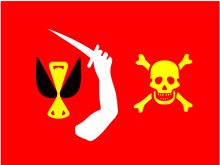Christopher Moody
Christopher Moody (fl. 1718-1722) was a pirate as a member of Bartholomew Roberts' crew but was never a Captain in his own right. He is best known not for his own actions but for a popular Jolly Roger flag mis-attributed to him as well as for later authors confusing him with unrelated pirate William Moody.

The Real Christopher Moody
Christopher Moody was a member of Howell Davis's crew aboard the sloop Buck after Davis staged a mutiny, took over the vessel, and turned to piracy in 1718. Davis sailed to the western coast of Africa where he cooperated with fellow pirates Jeremiah Cocklyn and Olivier Levasseur.[1] This was the only time the two Moodys potentially crossed paths: William Moody had recently ejected the quarrelsome Cocklyn but was in turn marooned by his own sailors. Davis was killed during an attempted raid on Principe and Roberts was elected Captain in his place.[2]
Christopher Moody stayed with Roberts until they were caught by the Royal Navy ship Swallow in 1722.[3] Witnesses at their trial described Moody as “behaving in a vile outrageous Manner, putting them in bodily Fears, sometimes for the Ship, and sometimes for themselves” and arguing with other forced crewmates. Another witness said that Moody “bully'd well among them who dar'd not make any Reply, but was very easy with his Friends, who knew him; for Moody, on this Occasion, took a large Glass from him, and threatened to blow his Brains out, (a favourite Phrase with these Pyrates) if he muttered at it.”[1] After Moody was captured he was hanged at Cape Coast Castle in Cabo Corso, Ghana with Thomas Sutton and other former members of Roberts' crew.[3]
Though perpetrated by William Moody, other actions - that he commanded a ship or two and that he plundered vessels off the Carolina coast - are often ascribed to Christopher Moody.[4] Period accounts such as the memorial by merchant William Snelgrave (who had been captured by Davis and Cocklyn) mention only the last name “Moody.”[2] Later depositions from pirates put on trial make clear that the pirate captain active off the Carolinas aboard his ship Rising Sun was William Moody, later overthrown by Cocklyn.[5]
Moody's Supposed Jolly Roger
A distinct and unique Jolly Roger flag is often attributed to Christopher Moody. Instead of the traditional white on black, Moody's Jolly Roger is depicted as gold on red. It also has an hourglass with wings, to express to his victims that their time to live was flying away. In the middle is a white arm holding a dagger.[6]
While popularly attributed to Christopher Moody, the flag may have been another pirate's, or may have been fictional.[7] The flag had been described in the mid-18th century, but the first record of its being attributed to Christopher Moody appeared in 1933 in Gray's “Pirates of the Eastern Seas.”[8] An artist's conception of the flag appears in Bradlee's "Piracy in the West Indies and its Suppression" (1923) but is dated to 1746, years after Moody died.[9] Christopher Moody was never a Captain and so would not have had a flag of his own in any event.[7]
See also
- Chaloner Ogle - the Royal Navy Captain who killed Bartholomew Roberts and captured his crew, including Christopher Moody
References
- Johnson, Captain Charles (1724). A GENERAL HISTORY OF THE PYRATES. London: T. Warner. Retrieved 18 June 2017.
- Snelgrave, William (1754). A new account of Guinea, and the slave-trade, containing, I. The history of the late conquest of the kingdom of Whidaw by the king of Dahome ... II. The manner how the negroes become slaves ... III. A relation of the author's being taken by pirates, and the many dangers he underwent. London: J. Wren. Retrieved 12 November 2019.
- Downie, Robert (2005). The Way of the Pirate: Who's Who in Davy Jones' Locker. New York: ibooks. ISBN 9781416504160. Retrieved 11 July 2019.
- Rankin, Hugh F. (1960). The Pirates of Colonial North Carolina (2008 Reprint ed.). Raleigh: Office of Archives and History, North Carolina Department of Cultural Resources. ISBN 978-0-86526-331-4. Retrieved 22 November 2019.
- Fox, E. T. (2014). Pirates in Their Own Words. Raleigh NC: Lulu.com. ISBN 9781291943993. Retrieved 17 June 2017.
- Pickering, David (2006). Pirates. New York: Collins. p. 151. Retrieved 22 November 2019.
- Fox, E. T. (2015). Jolly Rogers, the True History of Pirate Flags. Raleigh NC: Lulu.com. pp. 13–19. ISBN 9781326448172. Retrieved 3 December 2018.
- Grey, Charles (1933). Pirates of the eastern seas (1618-1723): a lurid page of history. London: S. Low, Marston & co., ltd. Retrieved 26 June 2017.
- Bradlee, Francis Boardman Crowninshield (1923). Piracy in the West Indies and its suppression (Rio Grande Press 1990 reprint ed.). Salem MA: The Essex Institute. p. n5. Retrieved 3 December 2018.
